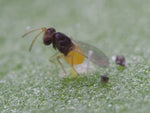Subscribe and save 10%!

Beneficial animal mix against "whiteflies" / mealybugs
€19,95 EUR
Unit price perExpected delivery date: 20 December to 27 December.
Applies to orders within Sweden. For other countries - see our delivery terms .
In stock
Share
€19,95 EUR
Unit price perBeneficial animal against mealybug/"white fly" infestation, in packs of 500 or 1000 pieces.
The product cannot be ordered during the winter.
Orders placed by Sunday evening will be shipped the following Tuesday.
The parasitic wasp, Encarsia formosa , is about 1 mm long and yellow and black in color. They are delivered as pupae glued to a card, in packs of 500 or 1000. These pupae are called “black scales” and during the first week the pupae hatch by the parasitic scales gnawing their way out through a small hole.
The hatched parasitic wasp actively searches for larvae of “white flies” to parasitize. They lay their eggs inside the host larvae (which are white). After about 14 days, these parasitized larvae turn black. After another 14 days, adult parasitic wasps hatch from the puparia.
Encarsia formosa only lay eggs in the last larval stages of "white flies", they do not kill adults. Fully grown individuals can live up to 4 weeks and will therefore fly around and lay new eggs even if livestock has been released. It may therefore be an advantage to treat with insecticidal soap before the parasitic wasps are released.
The desired temperature when setting out is above 17°C.
User manual
The parasitic wasp is delivered as black pupae glued to cardboard. The box with the cards is opened only when the plants are infested. Hang the cards on the plants, protected from sunlight.
Follow the fight
In the following weeks, there should be more and more “black pupae” on the plants in relation to the mealybug larvae. However, it may be necessary to spray the plant tops lightly with, for example, insecticidal soap to reduce the number of adults.
- Choosing a selection results in a full page refresh.
- Opens in a new window.





